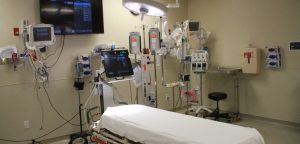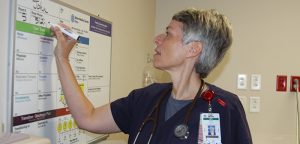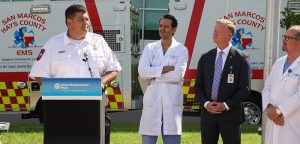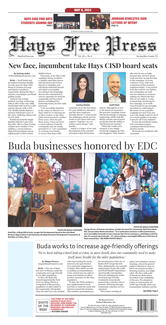By Kim Hilsenbeck
Hospitals are changing the way they deliver patient care, spurred in part by the Affordable Healthcare Act (ACA). With a focus on quality, not quantity of care, decision makers in hospitals nationwide are implementing a variety of measures to provide more effective care.
Government sponsored health insurance plans, such as Medicare and Medicaid, are moving toward paying for keeping patients healthy. For example, once discharged, is a patient coming back to the hospital for the same complaint? That could affect how a hospital gets reimbursed.
At Seton Medical Center Hays (Seton Hays) in Kyle, the new Clinical Decision Unit (CDU) is helping, to the extent possible, to ensure patients don’t return with the same issues.
The new nine-bed unit opened earlier this spring with the intent of providing diagnostic testing outside the emergency room (ER). Medical service in an ER is often the highest cost of care in hospitals.
A CDU, according to Seton Hays’ Clinical Nursing Supervisor Sara Shannon, is part of a new national trend.
“Hospitals are starting to consider [CDUs] as part of the patient care mix,” she said during a recent interview.
Jeffery Hummel, director of emergency services for the Seton Hays CDU, said, “You can’t get a good diagnostic picture in the ER in a few hours. The CDU offers the comfort of an inpatient room to run the tests needed to make a good decision on where [the patient] needs to go for the best care.”
In some cases, the decision may be to move the patient to one of the main hospital floors. In other cases, it could be to connect the patient with a private care physician in the community. And for others, once all the diagnostic results are in, the CDU staff may discharge the patient.
Seton Hays opened its CDU in March. Is it working as conceptualized?
Seton Hays’ chief executive officer Neal Kelley said yes.
“When I got here [in 2013], we were bumping up against capacity issues,” he said in a recent phone interview. “We had long ER wait times for beds upstairs. The CDU addresses that issue. Patients in observation status can go there and be more comfortable while waiting.”
He said the CDU takes pressure off of the ER and frees up ER beds for patients who need emergency services quickly. But patients don’t all come from the ER into the CDU. Some arrive there after surgery.
“It’s a flexible model for whatever a particular patient needs,” Kelley said. “Patients receive the same kind of care as on floors, but with a kind of a short stay mentality.”
As an example, he said, a patient who comes into the ER with chest pains may end up in the CDU because while he may have been ruled out for heart attack, the clinical staff is waiting on final test results. That patient would be occupying an ER bed, whereas with the CDU, that ER bed is now free.
The average stay in the CDU is about 24-36 hours, Shannon said.
“They don’t have to go through the whole admission process of being an inpatient,” Kelley said.
Has Seton Hays realized any cost savings as a result of opening the CDU?
Kelley said attaching a bottom line dollar amount to the CDU model is difficult.
“The CDU was never a cost-driven model to begin with,” Kelley said. “It’s about the quality of care and allowing us to get patients in the best environment for what they need.”
However, Dr. Rhett Reed, who oversees Seton Hays’ emergency department including the CDU, said by having shorter wait times in the ER, there is probably a bottom line effect, but it’s too early in the process to accurately measure any cost savings.
How does Seton Hays measure the success of the CDU?
“It’s really the health outcomes of the patients we’re serving,” Hummel said. “If we’re making good decisions about where they’re being taken care of clinically, then that’s really our measure.”
If a patient comes into the ER with chest pains, Hummel said, “Whether it’s the patient’s heart, stomach or pulled muscle, we should know that before you leave. It’s about connecting them to where they need to go for the next step.”
In part, Seton Hays can track the success of patient healthcare outcomes by conducting follow-ups once a patient is discharged.
Reed and other doctors will follow up with patients after they are discharged. In addition, the hospital uses an outside research vendor to measure patient satisfaction scores.
Kelley said Seton Hays receives consistently high scores.
“That’s not to say we get it right 100 percent of the time,” he added, acknowledging a few misdiagnosed cases in recent years, “but we get it right a lot of the time.”
He said the staff at Seton constantly focus on getting better and doing things with improvement in mind.







